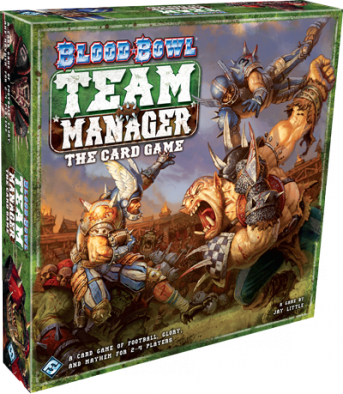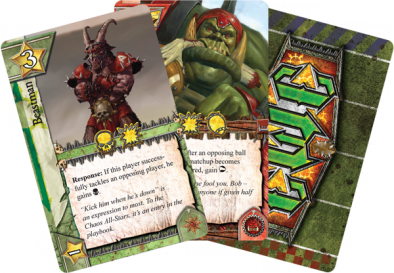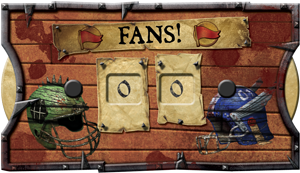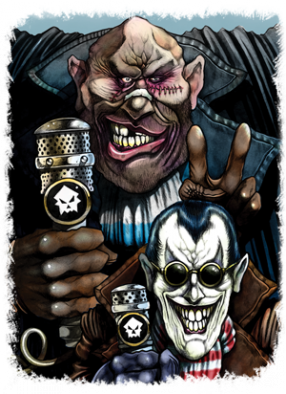Blood Bowl: Team Manager Reviewed
September 27, 2011 by brennon
Blood Bowl in my humble opinion is one of the best products Games Workshop have ever made. The rule set is second to none with some fantastically well realised teams and some amazing balance. The flavour too is funny, epic and full of character, allowing you to really immerse yourself in the Old World and its fantasy football mindset. So when it comes to looking at games within the IP it was always going to be hard for something to top the experience of playing Blood Bowl on the board.
Well, Fantasy Flight have decided to take up that challenge with Blood Bowl: Team Manager. A stand alone card game featuring some of the most iconic teams from the game where you as the coach must ensure your team not only survives the week-by-week games, but also makes it to the big time and gets their name etched on the magnificent Blood Bowl Cup. But the real question here is does the card game emulate its board game counterpart well enough for it to still feel like Blood Bowl? After about two dozens games I can assure you that it really, really does!
Components
As with everything in the Fantasy Flight range Blood Bowl: Team Manager comes with everything you will need to play the game from counters to cards. The trademark wheel design comes into play with their impressive looking and sturdy fan counters which record your victory as things progress. Unlike some of their games the wheels don't stick, or feel too loose which is a thankful addition. As well as the cardboard fan counters there are also a plethora of tokens. These take the shape of counters to mark which star players are yours, cheating tokens, and ball tokens (can't play Blood Bowl without a ball!). Each of them again are sturdy bits of cardboard and will most likely take the wear and tear of general play. The finish to these tokens is also pretty impressive, with plenty of glossy colour and the star player markers each having the iconic image of the teams from the board game.
Cards however is what this game is about, and there are a lot of cards. Highlight cards are used for the majority of the game and feature lines of fluff text to be read allowed, all highlighting a specific moment in the match that was worthy of Jim and Bob's attention. Alongside the Highlight deck sits the two star player piles, one for the 'good guys' and one for the 'bad guys'. Each is packed with not only star players but also freebooters and of course the impressive Morg n' Throg. Every single one of these features some outstanding artwork from either the board game itself, the Blood Bowl computer game and even in some cases new original art. Like the tokens they are glossy and richly detailed with plenty of funny flavour text.
Another two decks are the Staff deck, used for all round vital abilities like Apothecaries and sub-coaches and the upgrade decks for your specific teams. These are racial boons that just make things better for you in the long run. They range from an Orc one which allows a player to go into a Waaaaagh! to a Wood Elf one which forces a player to re-roll one of the tackle dice against you. The really important cards in the game of course are the teams themselves. Featuring artwork again from plenty of sources they are pretty impressive looking. Nice glossy finishes, clearly defined powers and plenty of fun flavour text to get you in the mind set of a particular team. It's no surprise my favourite so far is the Dwarf team!
Gameplay
And finally we come to the real meat of the game, the play itself. Like some of Fantasy Flight's games the rules are deceptive at first. On reading the rulebook it can seem a little complicated but once you put the ideas into practise it doesn't take long for you to realise that the rules are pretty simple. The challenge of the game comes in the tactical decisions you make as you play, looking for what other teams are doing and trying to counter it while also benefiting yourself. So, we will go through a sample turn and flesh out the rules as we go.
At the start of the game everyone choose a team and places their various gubbins in front of them. Then they draw six players from their shuffled deck and this is their team for the first week of the season. Once that is done the lead player (marked with a massive Blood Bowl coin) turns over the condition card for that week. This could be a bonus to players, like allowing them to draw a star player for free. It could also be detrimental to all, for example soggy pitch which makes tackling painful! As well as this two of the cards are going to be Tournaments which we will go into later. Once the condition has been revealed the player going first turns over the number of highlights for that week. Highlights are specific points within a match where something has truly rocked the fans and you will be recreating those moments with your teams. The number of Highlight cards is linked to the amount of players so for three players, three highlights etc.
Once the Highlights have been placed on the board they will each have two sides and a midfield objective. The side icons represent what you will gain regardless of winning or losing. The midfield icons represent what you get when you win. Players can play on either side of the pitch looking at their progression so far in order to judge which is most beneficial to them in the long run. Going round the table each player will choose a player from their roster and devote it to a highlight match up. There is no cost in doing so, a 3 star Dwarf Blocker is just as eligible as a 1 star Dwarf Longbeard for example. And here is where the meat of the game comes.
Each player has a set of icons on them and some have special rules. When you play one of your team you resolve the icons across the card. This could be a Tackle icon which allows you to make a tackle on another player. It can also be a pass action allowing you to claim the ball, sprints which allow you to cycle through your deck and most interesting of all, cheat icons which put a random cheat token onto your card. Tackling is the only action which takes up a few moments of time, where you compare the star rating of your player to the one you are tackling. If you have higher than them, you roll 2 dice and pick the result. If you're the same you roll 1 dice (risky!) and lower 2 dice and the opponent picks (even riskier!). Once all players have been assigned to highlights and all actions resolved, the next phase is the scoreboard phase.
One interesting addition to the Highlights is a card I mentioned earlier, tournaments. These are for example the Chaos Cup and make up mid-season match ups where all teams compete for a little extra glory. In the case of a normal Highlight only two teams can compete, one on each side of the card. But in a Tournament everyone gets to throw their weight into it. A highlight therefore shows off one game between two teams, and a Tournament exhibiting a grand slam between teams all clambering for the top spot. It is frantic stuff since anyone can tackle anyone!
So then comes the scoreboard phase. Here you compare the star player points of each side and whoever has the highest wins the match up. Both sides gain the icons represented on their half of the pitch, and the winner claims the midfield bonus. If a team is every unopposed they gain ALL of the icons on the card which is pretty powerful stuff. One curve ball in this phase is the Cheat tokens. Powerful players usually always have a cheat token assigned to them and when revealed can either be bonus star power, more fans, or even in some cases a sending off! If a player is ever sent off, he is put on the discard pile and his star power counts for nothing. This means you really have to be careful with who you play in what zone, because even though it might look like your winning if all the cheat tokens revealed come up sent off you have suddenly lost the match up! This is why Team Manager is such an in-depth tactical game. Every risk has to be gauged and thought over and you have to try and plan for every eventuality.
Once all highlights have been resolved you gather up all your cards, clear the player area, reveal your winnings to all players so everyone knows what you drew and pass the initiative along. From there you begin again playing through the rounds as before until you reach the Blood Bowl cup. Once that final week of the season has been played the coach with the most fans wins the season and is crowned victorious!
Conclusion
Team Manager is a game which follows the saying "easy to learn, hard to master". The mechanics are simple enough that anyone could pick it up in a single round. The difficulty comes from working out what is going to earn you the most fans, what combination of factors is going to bring about your victory at the end. You will find yourself looking at match ups and avoiding certain teams, playing around them in a hope of bypassing their power. In other cases you will find yourself hunting down the lead player and trying to deny him his fans. It almost feels like a game within a game. Your own private one looking to your victory, and the wider one, stopping them from getting it before you!
All the teams, I feel, accurately mirror their board game counterparts. The Reikland Reavers feel jack of all trades. The Gouged Eyes are lovers of the brawl. Skavenblight Scramblers are a passing team with plenty of cheat tokens. Athelorn Avengers excel at the sprinting game, cycling through your deck for maximum efficiency. The Grudgebearers are hard as stone, able to take masses of punishment. The Chaos All Stars are impressive in might and love a balance of tackling and cheating. I was overjoyed with how well they seemed to mirror the miniature game and it really does feel like every side handles differently.
There really are very few complaints I can make about this game. It feels good to play, enjoyable, easy to learn and teach to others and full of moments of hilarity and out right awesomeness. There are occasionally times when you can feel as if there is no point in you playing on, especially if your draws have been bad two or three turns in a row. However a counter to that is that there is always another route to victory. We have had games where it has seemed like a player is losing and then shot up in score from an unexpected windfall on a staff card for example.
The biggest boon however to playing this game is that when we taught it to a friend of ours who had never played Blood Bowl before, he was suddenly curious about the board game itself. It was fantastic to see a game actually providing a gate way to the miniatures game and then to have us as regular players know that if he did get into it, he could easily see parallels between the play styles in the card game and board game.
Now all we need Fantasy Flight to do is bring out some expansions for this. I want to play as Norse!
Components: 5/5
Gameplay: 5/5
Seriously when Blood Bowl: Team Manager comes out in October, go and get this game. If you love cards games or Blood Bowl it will truly be a prize part of your collection.
Supported by (Turn Off)
Supported by (Turn Off)
Supported by (Turn Off)

















































































Looks intresting.
It does indeed. Lets see what the crowd on boardgamegeek thinks.
Played this at GenCon and agree 100%. It’s fun as hell to play, even when your team is getting thrashed. Hope they bring out some more teams, though. More options would be nice.
Does it make a difference to the game with more or less people? Is it more fun with 4? and not so fun with just 2?
I cant wait to play this!!!